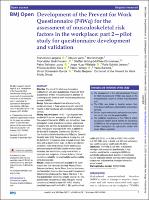Please use this identifier to cite or link to this item:
https://repositorio.usj.es/handle/123456789/791
| Title: | Development of the Prevent for Work Questionnaire (P4Wq) for the assessment of musculoskeletal risk factors in the workplace: Part 2 - Pilot study for questionnaire development and validation |
| Authors: | Langella, Francesco



Vanni, Daniele 
Høgh, Morten 
Palsson, Thorvaldur S. 


Christensen, Steffan Wittrup Mc Phee 

Bellosta-López, Pablo 

Villafañe, Jorge Hugo 


Jensen, Palle S. 
de Brito Silva, Priscila 
Herrero Gállego, Pablo 


Barletta, Paolo 
Doménech-García, Víctor 

Berjano, Pedro L. 


|
| Keywords: | back pain; health & safety; mental health; musculoskeletal disorders; risk management |
| Issue Date: | Nov-2021 |
| Publisher: | BMJ Journals |
| Abstract: | Objective. The aim of this study was to develop a multifactorial, self-report questionnaire: Prevent for Work Questionnaire (P4Wq). The questionnaire is intended for screening for risk factors in work-related musculoskeletal disorders (WMSDs). Design. Data were collected from otherwise healthy workers employed in three service areas at a specialist hospital in Italy: healthcare, administration and ancillary services. Setting and participants. In all, 115 participants were enrolled (67% women; average age 41.5±9.94 years). The content of the tool for WMSDs was derived from three participation rounds of analysis involving a select group of experts who identified the questionnaire domains and items. Participants responded to 89 items in addition to the EuroQol 5 Dimensions Questionnaire (EQ-5D-5L), Fear-Avoidance Beliefs Questionnaire (FABq) and Oswestry Disability Index (ODI). The proportion of missing data and the distribution of responses were analysed for each item. Items with a discrimination index >0.40 and an interitem correlation <0.80 were retained. Factor analysis was performed using the VARIMAX rotation method, factor extraction, and identification, assignment of items to subscales, and assignment of scores to items. Internal consistency, reliability, construct validity and face validity were also assessed. Results. A total of 52 items were included in the factor analysis and four subscales identified: Physical Stress Subscore (six items); Mental Stress Subscore (six items); Job Satisfaction Subscore (four items) and Kinesiophobia/Catastrophizing Subscore (four items). The items in the final questionnaire version had a factor loading >0.7. The questionnaire consisted of 20 items with good internal consistency (Cronbach’s alpha 0.81–0.91), reliability (weighted kappa coefficient 0.617–1.00), good construct validity (EQ-5D-5L, r=−0.549, p<0.001; ODI, r=0.549, p<0.001; FABq work, r=0.688, p<0.001) and satisfactory face validity (universal validity index 96.04%). Conclusion. The P4Wq is a 20-item, multifactorial self-report risk assessment questionnaire. It may provide a useful tool for screening for WMSDs by specifically addressing back disorders. It investigates risks for individual workers and may inform educational programmes and preventive strategies tailored to a worker’s needs. |
| URI: | https://repositorio.usj.es/handle/123456789/791 |
| ISSN: | 2044-6055 |
| Appears in Collections: | Artículos de revistas |
Files in This Item:
| File | Description | Size | Format | |
|---|---|---|---|---|
| development of the prevent for work questionnaire2.pdf | 1,5 MB | Adobe PDF |  View/Open |
This item is licensed under a Creative Commons License

